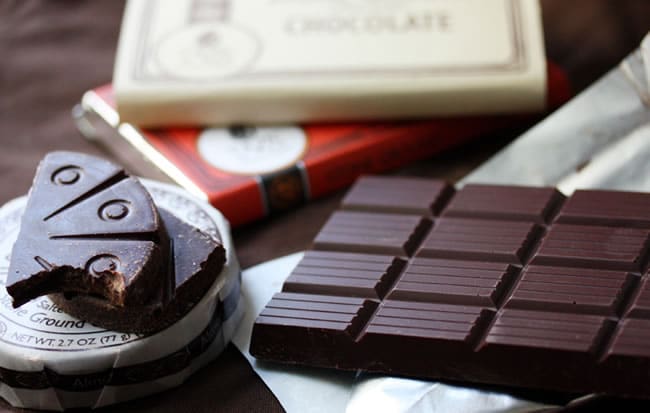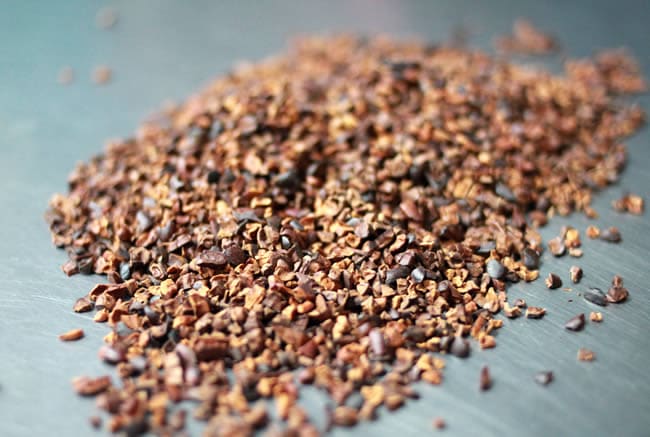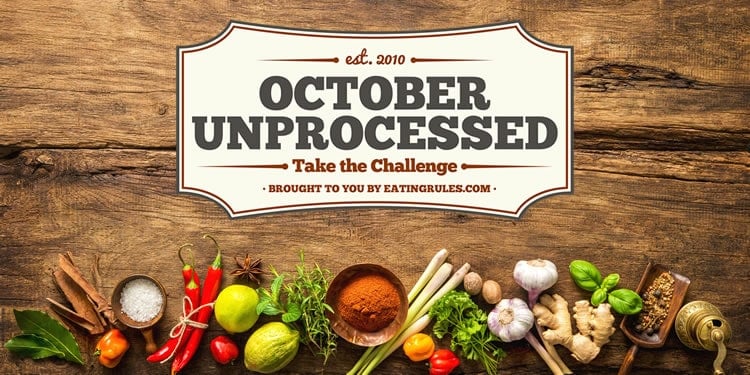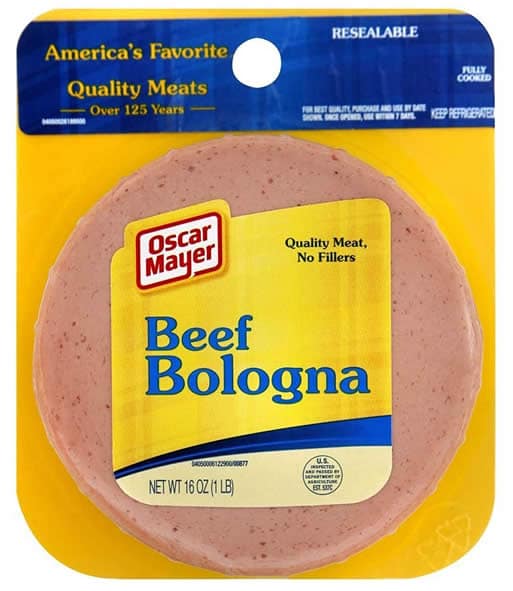Unprocessed FAQ: Chocolate
Oct 06, 2019

Hundreds of people have now taken the October Unprocessed challenge! If you haven’t taken the pledge yet, please do it today. (If you already eat this way all the time, take the pledge and show your support! And if you think it’s too daunting, how about just for two weeks? Or even a day? Do what you can, and take charge of your health!) … We’ve got a lot of momentum, and this is turning into something really powerful. Keep it up–and bring your friends!
—
Another of the most commonly asked questions about October Unprocessed and the Kitchen Test is, you guessed it: Chocolate.
There are a ton of different types of chocolate products, of course, and it can be tough (or at least tedious) to figure out which store-bought versions actually pass the kitchen test.
In theory, at least, chocolate is one of those unprocessed foods that easily passes the test. If you knew what you were doing, you could grow cacao, harvest and ferment the beans, dry them, roast them, crack them into nibs, grind them into liquor, conch the liquor (mixing it for several hours), temper it, and then add some sugar and form it into a fabulous home-made chocolate bar.
Here’s a great, thorough walk-through of how chocolate gets from farm to you. It would probably take you two or three weeks to get through all of those steps, but again, you could do it if you really wanted to. If you are a brave soul who has actually done any of this, please tell us about it in the comments!
If you’d like a shortcut to fantastic homemade chocolate (starting from cocoa powder), don’t miss Desiree’s guest post on how to make chocolate.
Cocoa Powder
Cocoa Powder is the non-fat component of chocolate (the fatty component is called cocoa butter). Sometimes listed as cocoa solids, it may also be called cacao or just cocoa. On its own it passes the kitchen test easily. This is also the part of the cocoa that has the most minerals and flavonoids. In other words, it may very well be the healthiest part of the chocolate.
However, if you come across “Cocoa processed with Alkali” or “Dutch-Processed Cocoa” (same thing), that means that they’ve added an alkali (a base) to the chocolate to counteract some of the acidity. From a health standpoint, you’re better off finding cocoa powder that has not been processed with alkali — because that processing destroys most of the beneficial flavonoids.
It’s tricky to actually find exactly which alkali has been used to process the cocoa, since it’s not usually listed in the ingredients. Potassium bicarbonate seems to be the most common. Personally, I’m going to avoid any cocoa powder that has been alkalized.

Chocolate Bars
Most store-bought chocolate bars contain emulsifiers, flavorings, or other additives that you wouldn’t or couldn’t use if you were to make it at home.
Lecithin (usually soy lecithin) seems to be the most common commercial additive. It’s an emulsifier that helps keep the cocoa and the cocoa butter from separating, which helps keep it looking good, even after it’s been sitting on the store shelf for a while. While lecithin may or may not be “good” for you (I don’t think it’s been studied enough, and it’s certainly not necessary in our diets), you certainly wouldn’t make it at home: To make soy lecithin, it’s extracted from soybeans using hexane.
Almost all chocolate bars contain sugar in some form or another — otherwise it would be too bitter to enjoy. (You can find 99% chocolate bars which are used for baking, not snacking). We’ll need to apply the kitchen test on the specific type of sugar they use (some just list “sugar,” others will be more specific).
Other chocolate candies may, of course, add flavorings or preservatives other things that probably don’t pass the kitchen test. For those, you’ll need to read the ingredients list and apply the test to each one.
As a general guide, the larger the company, the less likely the chocolate bars will pass muster (he said, staring towards Pennsylvania). However, there are some commercially available chocolate bars that pass the test, and in my experience, the darker the bar (82% or 85%!), the more likely it is to pass.
In the years since we started October Unprocessed, more and more companies that focus on fair trade and social/environmental justice have appeared, and they’re more likely to skip the additives — and thankfully we can find them much more easily than before (Careful, though: the major brands have caught on. For example, The Hershey Company bought Dagoba in 2006.) Some brands I like: Theo, Alter Eco, Equal Exchange, Taza, Gnosis.
Here’s also a thorough blog post that lists bars they’ve found without soy products (those may still use other taboo ingredients, but it’s a good place to start looking), and you might also want to check out the Food Empowerment Project’s slavery-free chocolate list.
If you know of more chocolate bars that pass the kitchen test, please share in the comments.
White Chocolate
White chocolate is a candy that’s made with sugar, milk, and cocoa butter. There are no cocoa solids (cocoa powder) at all. This may pass the kitchen test, depending on the specific ingredients and where you draw the line for yourself. But just remember that the beneficial parts of chocolate are found in the cocoa solids, so don’t think that you’re getting any health benefit from white chocolate.
Milk Chocolate
Milk Chocolate is a solid chocolate that’s been made with “milk.” I put that in quotes, because it may be milk powder, liquid milk, or condensed milk. These types of chocolates usually have a lot of sugar — in the United States, they’re only required to have a minimum of 10% of chocolate liquor (European states are a bit higher, in the 20-25% range). My read on most store-bought milk chocolate is that it’s probably not going to pass the kitchen test.
Raw Chocolate & Cacao Nibs
“Raw” Chocolate is one that hasn’t been processed or heated to the same degree as “typical” chocolate (details on “raw” tend to be a bit sketchy, and vary with each company). Cacao Nibs (Cocoa Nibs) are the dried beans, usually broken into little pieces, and are sold either before or after roasting (much like any other seed or nut).
Both of these are probably your best bet for October. I love cacao nibs sprinkled on top of my oatmeal — they give a nice crunch, and have a mild chocolate flavor. They’re chocolate chips in the truest sense! (I like Navitas Naturals.)
—
I think that about covers it for chocolate — did I miss anything? Do you have any recommendations of store-bought chocolate that pass the kitchen test?
If you haven't taken the October Unprocessed pledge yet, please do! And then encourage your friends to join in -- it's a lot more fun that way!
Hershey’s Milk Chocolate Wrapper © 2014 Andrew Wilder, shared under creative commons license.
Cacao Nibs After De-Chaffing © 2012 Daniel Brock, used under creative commons license.























Today I found a bar with pretty good ingredients: the Lindt Extra Dark 85% Cocoa. Ingredients are chocolate, cocoa butter, cocoa, demerrara sugar, and bourbon vanilla beans. NO soy lecithin!
After doing some more research (none of my chocolate bars would stay solid) I found out that unsweetened chocolate (also called baker’s chocolate or bitter chocolate) would pass the kitchen test, since it is just chocolate liquor mixed with cacoa nibs. It’s shelf stable and great for baking with.
In regard to Cocoa powder, the Dutch processing generally uses potassium carbonate. Food grade potassium bicarbonate is available so one could use an oven to thermally decompose the potassium bicarbonate into potassium carbonate, water, and carbon dioxide. Sodium carbonate can also be used. It could be obtained by thermal decomposition of baking soda. Someone comfortable with chemistry could easily Dutch process cocoa at home. It wouldn’t be significantly more difficult than nixtamalizing corn or making an alkaline bath for pretzels.
http://www.icco.org/about-cocoa/processing-cocoa.html
Do you have any recipes for cocoa powder/coconut oil ( like a cookie or something)?
One of my favorites:
Blitz in your food proccessor:
1 cup of almond or other nut meal(I love cashew)
2 cups of shredded coconut
3 tablespoons of maple syrup or coconut nectar
3 tablespoons of coconut oil
2 tablespoons of cocoa powder
1 teaspoon vanilla extract
when it starts to come into one big ball, turn off food processor and form into tablespoon sized balls. Store in the fridge
Thank you, Sabrina! I’m always looking for ways to use almond meal. It seems so wasteful to discard it after making almond milk. I can’t wait to try it.
I make a raw chocolate confection that is very much like this recipe, Sabrina. You can use chopped walnuts or, in my case, sometimes I use the almond paste remaining from making almond milk. Tasty either way!
Taza Chocolate is another good bean-to-bar operation. They make chocolate bars in different flavors, and they also sell yummy cacao nibs. (This is all assuming that the cane sugar they use passes the kitchen test. I’m pretty sure it does, but it might depend on how strictly you apply the test.)
I’m pretty sure that raw honey passes the kitchen test. Just add a little water and raw honey to cocoa powder….whip it with a fork and viola!..delicious chocolate fudge.
Isn’t the act of manufacturing a chocolate bar already processing? An unprocessed food would be the raw chocolate bean, wouldn’ it?
Almost every food we eat is “processed” in some way — so it really depends on how we define that word for ourselves. I use my kitchen test definition, which I’ve applied in this post. I encourage everyone to define “unprocessed” in a way that makes sense to them, so if you want to draw the line at raw chocolate beans, I say go for it! (But I’m not so sure you should eat them like that!) 🙂
Nice thoughts on chocolate processing! I’ve been reviewing chocolate on my blog recently and found quite a few yummy ones that pass my unprocessed test. The TJs stone ground bar that Jacqui mentioned is amazing! Some of my favorites are even refined sugar and soy lecithin free, as well as raw/very minimally processed. If you want to make your own unprocessed refined sugar free chocolate treats, I’ve got easy recipes, too.
Some of my fav unrefined sweeteners for homemade chocolate goodies are dates, coconut nectar, prunes, applesauce, and carob. Yes, carob! It’s not a good chocolate replacement, but it is sweet, nutritious and blends well with cocoa in the right proportions. Try making your own wholesome homemade chocolates, you’ll wow yourself and everyone you share them with!
http://www.laurawestkong.com/gff/tag/chocolate/ for chocolate reviews and recipes
Equal Exchange makes chocolate bars without lecithin. I buy them on iherb.com.
Heavenly Organics has a Honey Chocolate Mint Pattie my son and I enjoy =) just 3 ingredients! Thanks for the recommends everyone – I see a few I am going to check out!